MANAGERIAL ACCOUNTING.
VerifiedAdded on 2023/01/18
|17
|4221
|57
AI Summary
Contribute Materials
Your contribution can guide someone’s learning journey. Share your
documents today.
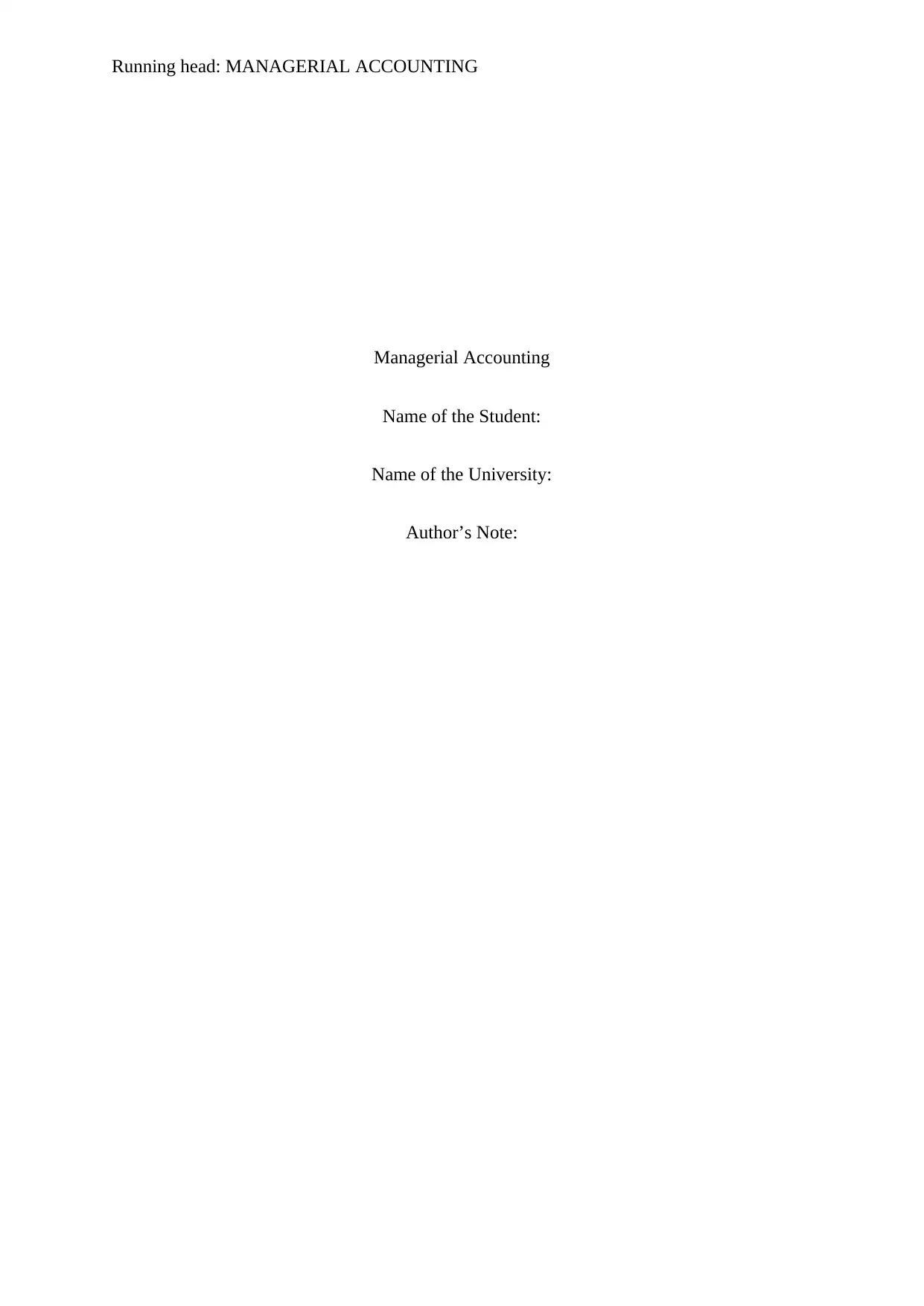
Running head: MANAGERIAL ACCOUNTING
Managerial Accounting
Name of the Student:
Name of the University:
Author’s Note:
Managerial Accounting
Name of the Student:
Name of the University:
Author’s Note:
Secure Best Marks with AI Grader
Need help grading? Try our AI Grader for instant feedback on your assignments.
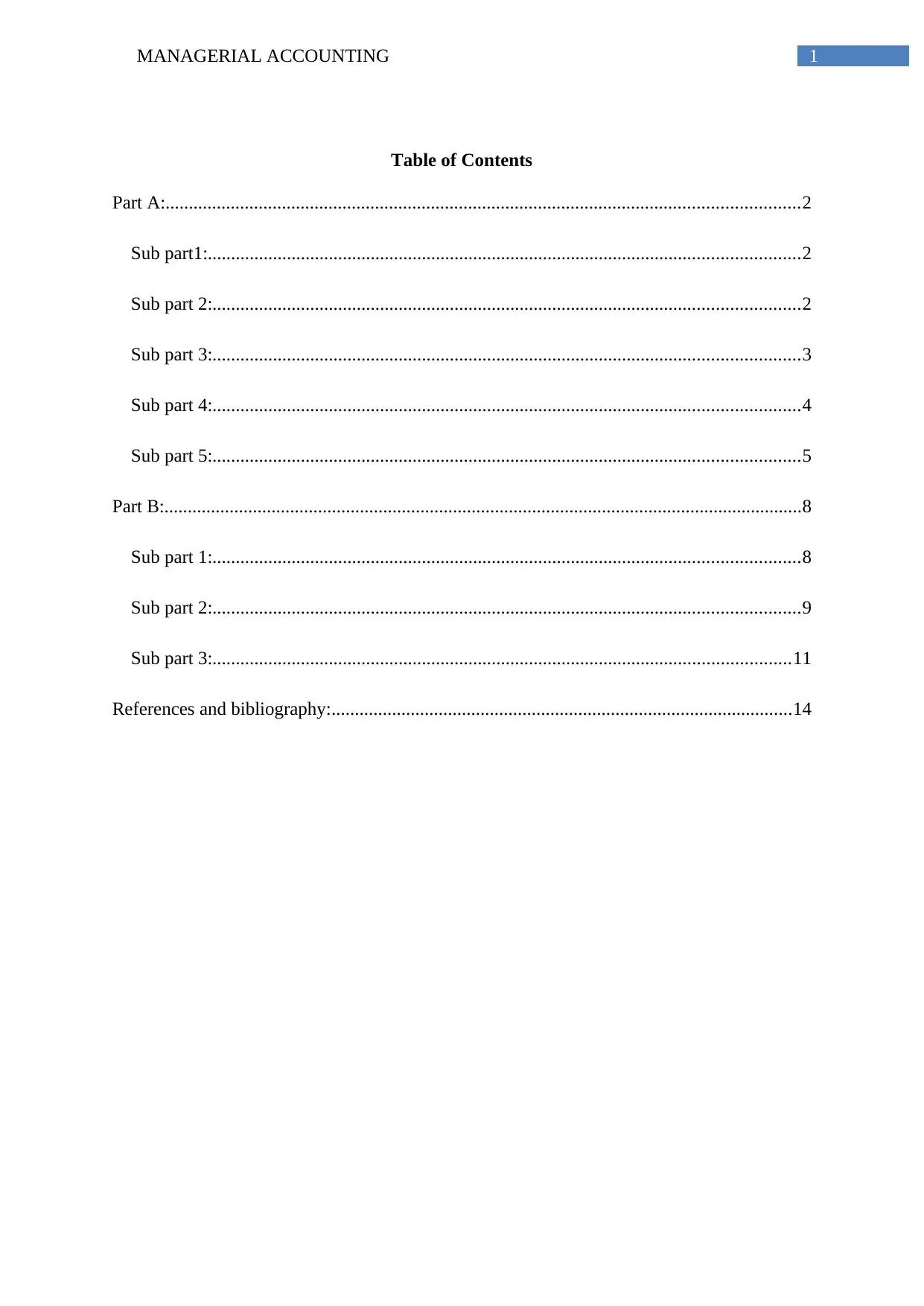
1MANAGERIAL ACCOUNTING
Table of Contents
Part A:........................................................................................................................................2
Sub part1:...............................................................................................................................2
Sub part 2:..............................................................................................................................2
Sub part 3:..............................................................................................................................3
Sub part 4:..............................................................................................................................4
Sub part 5:..............................................................................................................................5
Part B:.........................................................................................................................................8
Sub part 1:..............................................................................................................................8
Sub part 2:..............................................................................................................................9
Sub part 3:............................................................................................................................11
References and bibliography:...................................................................................................14
Table of Contents
Part A:........................................................................................................................................2
Sub part1:...............................................................................................................................2
Sub part 2:..............................................................................................................................2
Sub part 3:..............................................................................................................................3
Sub part 4:..............................................................................................................................4
Sub part 5:..............................................................................................................................5
Part B:.........................................................................................................................................8
Sub part 1:..............................................................................................................................8
Sub part 2:..............................................................................................................................9
Sub part 3:............................................................................................................................11
References and bibliography:...................................................................................................14
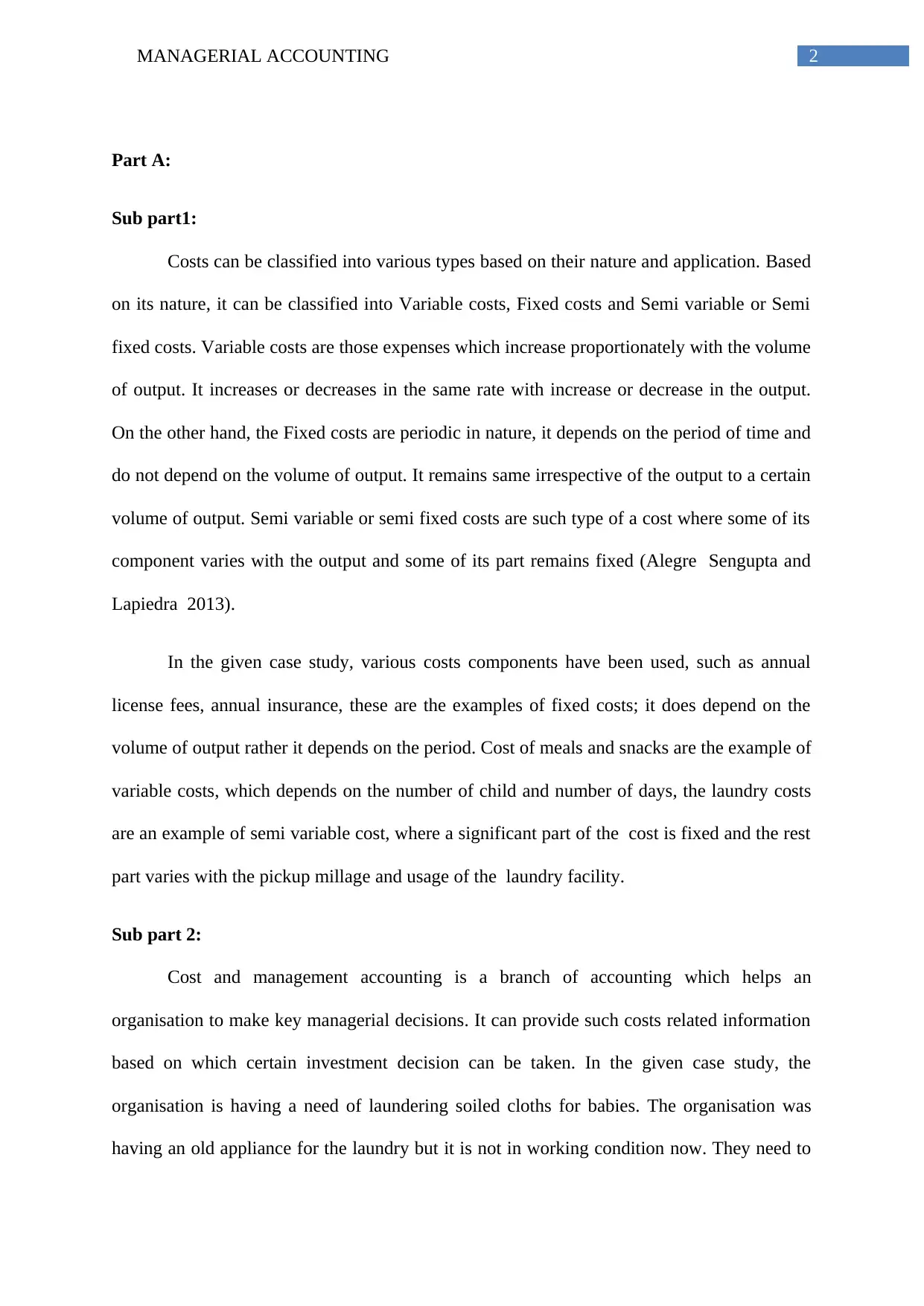
2MANAGERIAL ACCOUNTING
Part A:
Sub part1:
Costs can be classified into various types based on their nature and application. Based
on its nature, it can be classified into Variable costs, Fixed costs and Semi variable or Semi
fixed costs. Variable costs are those expenses which increase proportionately with the volume
of output. It increases or decreases in the same rate with increase or decrease in the output.
On the other hand, the Fixed costs are periodic in nature, it depends on the period of time and
do not depend on the volume of output. It remains same irrespective of the output to a certain
volume of output. Semi variable or semi fixed costs are such type of a cost where some of its
component varies with the output and some of its part remains fixed (Alegre Sengupta and
Lapiedra 2013).
In the given case study, various costs components have been used, such as annual
license fees, annual insurance, these are the examples of fixed costs; it does depend on the
volume of output rather it depends on the period. Cost of meals and snacks are the example of
variable costs, which depends on the number of child and number of days, the laundry costs
are an example of semi variable cost, where a significant part of the cost is fixed and the rest
part varies with the pickup millage and usage of the laundry facility.
Sub part 2:
Cost and management accounting is a branch of accounting which helps an
organisation to make key managerial decisions. It can provide such costs related information
based on which certain investment decision can be taken. In the given case study, the
organisation is having a need of laundering soiled cloths for babies. The organisation was
having an old appliance for the laundry but it is not in working condition now. They need to
Part A:
Sub part1:
Costs can be classified into various types based on their nature and application. Based
on its nature, it can be classified into Variable costs, Fixed costs and Semi variable or Semi
fixed costs. Variable costs are those expenses which increase proportionately with the volume
of output. It increases or decreases in the same rate with increase or decrease in the output.
On the other hand, the Fixed costs are periodic in nature, it depends on the period of time and
do not depend on the volume of output. It remains same irrespective of the output to a certain
volume of output. Semi variable or semi fixed costs are such type of a cost where some of its
component varies with the output and some of its part remains fixed (Alegre Sengupta and
Lapiedra 2013).
In the given case study, various costs components have been used, such as annual
license fees, annual insurance, these are the examples of fixed costs; it does depend on the
volume of output rather it depends on the period. Cost of meals and snacks are the example of
variable costs, which depends on the number of child and number of days, the laundry costs
are an example of semi variable cost, where a significant part of the cost is fixed and the rest
part varies with the pickup millage and usage of the laundry facility.
Sub part 2:
Cost and management accounting is a branch of accounting which helps an
organisation to make key managerial decisions. It can provide such costs related information
based on which certain investment decision can be taken. In the given case study, the
organisation is having a need of laundering soiled cloths for babies. The organisation was
having an old appliance for the laundry but it is not in working condition now. They need to
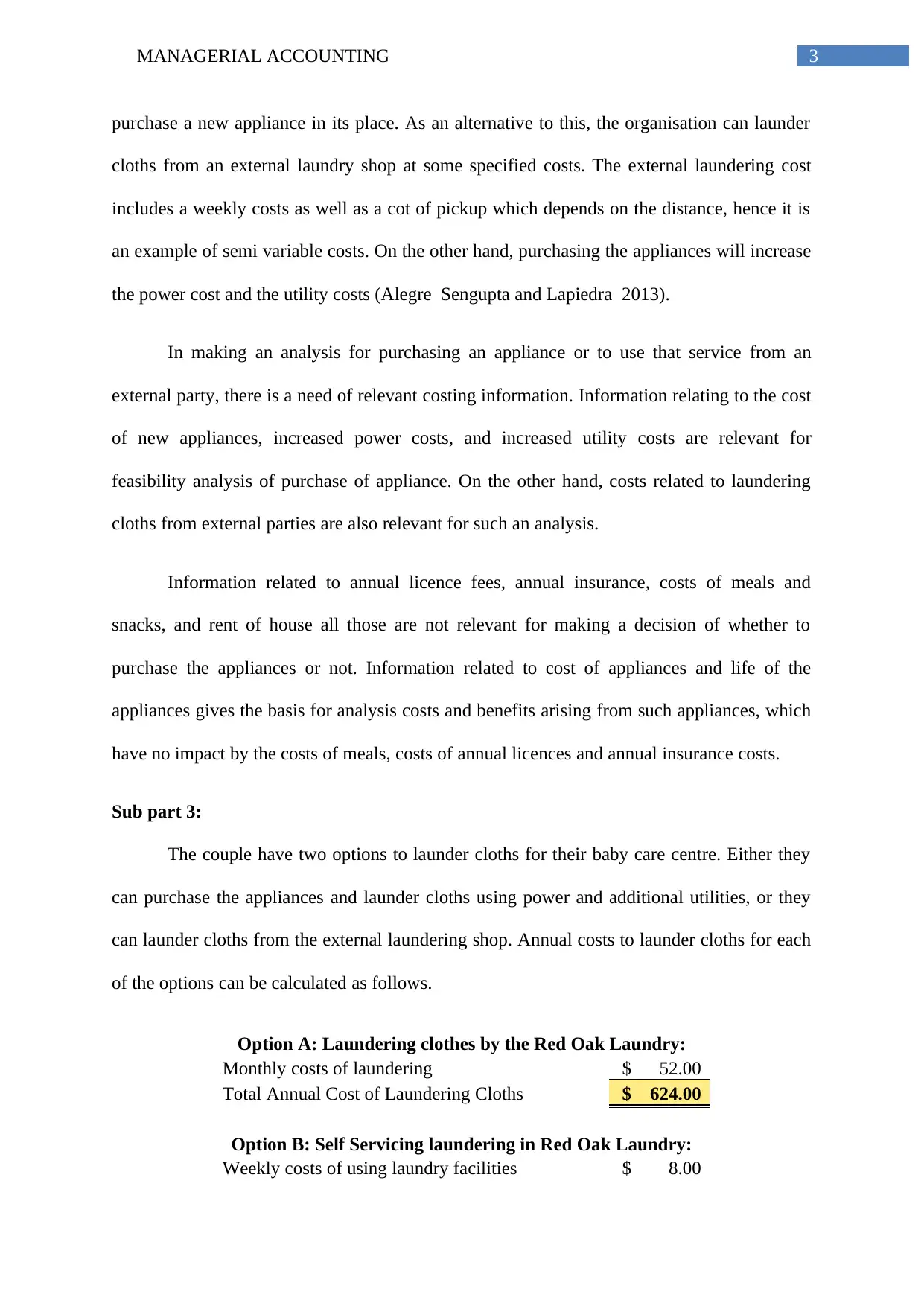
3MANAGERIAL ACCOUNTING
purchase a new appliance in its place. As an alternative to this, the organisation can launder
cloths from an external laundry shop at some specified costs. The external laundering cost
includes a weekly costs as well as a cot of pickup which depends on the distance, hence it is
an example of semi variable costs. On the other hand, purchasing the appliances will increase
the power cost and the utility costs (Alegre Sengupta and Lapiedra 2013).
In making an analysis for purchasing an appliance or to use that service from an
external party, there is a need of relevant costing information. Information relating to the cost
of new appliances, increased power costs, and increased utility costs are relevant for
feasibility analysis of purchase of appliance. On the other hand, costs related to laundering
cloths from external parties are also relevant for such an analysis.
Information related to annual licence fees, annual insurance, costs of meals and
snacks, and rent of house all those are not relevant for making a decision of whether to
purchase the appliances or not. Information related to cost of appliances and life of the
appliances gives the basis for analysis costs and benefits arising from such appliances, which
have no impact by the costs of meals, costs of annual licences and annual insurance costs.
Sub part 3:
The couple have two options to launder cloths for their baby care centre. Either they
can purchase the appliances and launder cloths using power and additional utilities, or they
can launder cloths from the external laundering shop. Annual costs to launder cloths for each
of the options can be calculated as follows.
Option A: Laundering clothes by the Red Oak Laundry:
Monthly costs of laundering $ 52.00
Total Annual Cost of Laundering Cloths $ 624.00
Option B: Self Servicing laundering in Red Oak Laundry:
Weekly costs of using laundry facilities $ 8.00
purchase a new appliance in its place. As an alternative to this, the organisation can launder
cloths from an external laundry shop at some specified costs. The external laundering cost
includes a weekly costs as well as a cot of pickup which depends on the distance, hence it is
an example of semi variable costs. On the other hand, purchasing the appliances will increase
the power cost and the utility costs (Alegre Sengupta and Lapiedra 2013).
In making an analysis for purchasing an appliance or to use that service from an
external party, there is a need of relevant costing information. Information relating to the cost
of new appliances, increased power costs, and increased utility costs are relevant for
feasibility analysis of purchase of appliance. On the other hand, costs related to laundering
cloths from external parties are also relevant for such an analysis.
Information related to annual licence fees, annual insurance, costs of meals and
snacks, and rent of house all those are not relevant for making a decision of whether to
purchase the appliances or not. Information related to cost of appliances and life of the
appliances gives the basis for analysis costs and benefits arising from such appliances, which
have no impact by the costs of meals, costs of annual licences and annual insurance costs.
Sub part 3:
The couple have two options to launder cloths for their baby care centre. Either they
can purchase the appliances and launder cloths using power and additional utilities, or they
can launder cloths from the external laundering shop. Annual costs to launder cloths for each
of the options can be calculated as follows.
Option A: Laundering clothes by the Red Oak Laundry:
Monthly costs of laundering $ 52.00
Total Annual Cost of Laundering Cloths $ 624.00
Option B: Self Servicing laundering in Red Oak Laundry:
Weekly costs of using laundry facilities $ 8.00
Secure Best Marks with AI Grader
Need help grading? Try our AI Grader for instant feedback on your assignments.
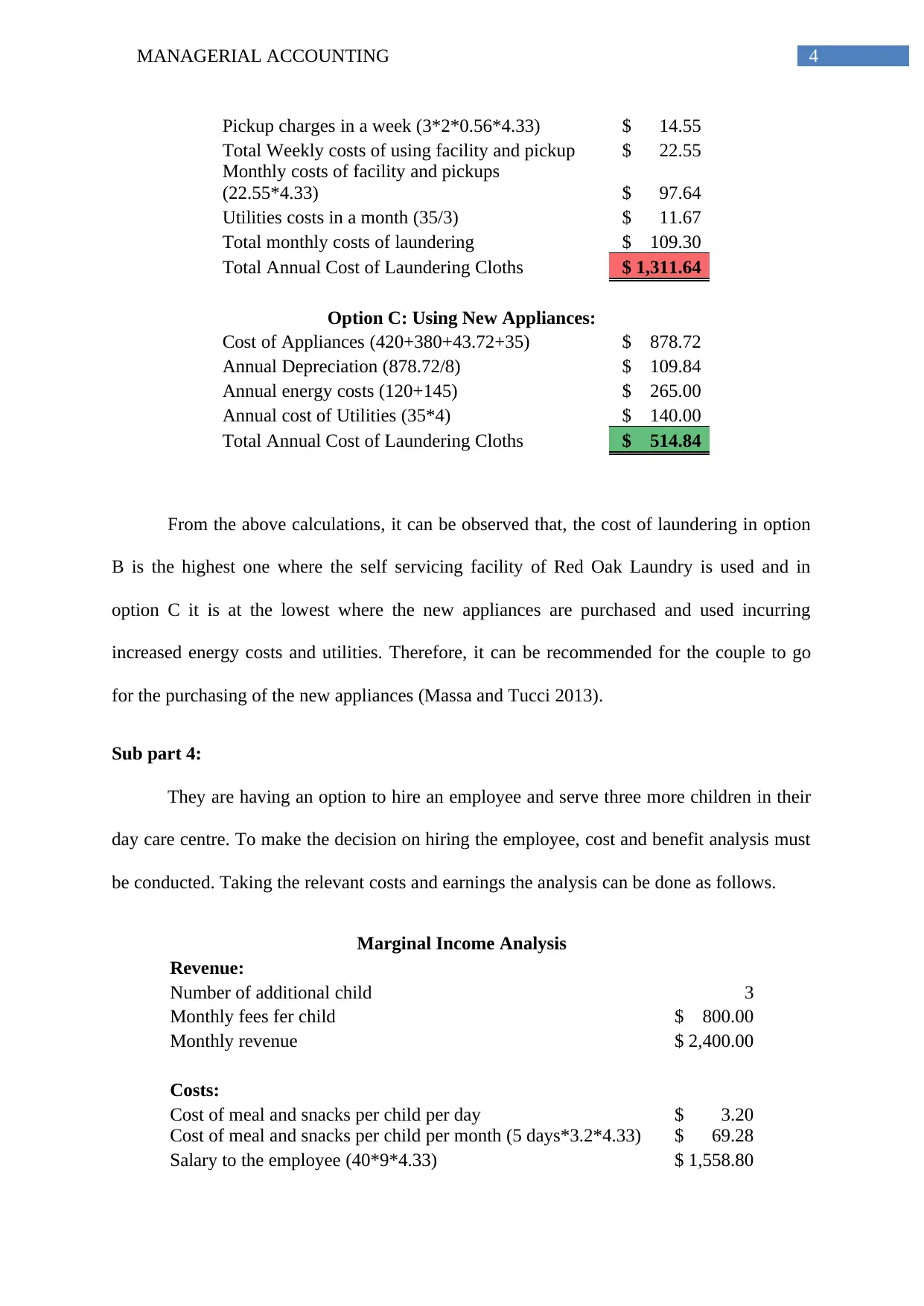
4MANAGERIAL ACCOUNTING
Pickup charges in a week (3*2*0.56*4.33) $ 14.55
Total Weekly costs of using facility and pickup $ 22.55
Monthly costs of facility and pickups
(22.55*4.33) $ 97.64
Utilities costs in a month (35/3) $ 11.67
Total monthly costs of laundering $ 109.30
Total Annual Cost of Laundering Cloths $ 1,311.64
Option C: Using New Appliances:
Cost of Appliances (420+380+43.72+35) $ 878.72
Annual Depreciation (878.72/8) $ 109.84
Annual energy costs (120+145) $ 265.00
Annual cost of Utilities (35*4) $ 140.00
Total Annual Cost of Laundering Cloths $ 514.84
From the above calculations, it can be observed that, the cost of laundering in option
B is the highest one where the self servicing facility of Red Oak Laundry is used and in
option C it is at the lowest where the new appliances are purchased and used incurring
increased energy costs and utilities. Therefore, it can be recommended for the couple to go
for the purchasing of the new appliances (Massa and Tucci 2013).
Sub part 4:
They are having an option to hire an employee and serve three more children in their
day care centre. To make the decision on hiring the employee, cost and benefit analysis must
be conducted. Taking the relevant costs and earnings the analysis can be done as follows.
Marginal Income Analysis
Revenue:
Number of additional child 3
Monthly fees fer child $ 800.00
Monthly revenue $ 2,400.00
Costs:
Cost of meal and snacks per child per day $ 3.20
Cost of meal and snacks per child per month (5 days*3.2*4.33) $ 69.28
Salary to the employee (40*9*4.33) $ 1,558.80
Pickup charges in a week (3*2*0.56*4.33) $ 14.55
Total Weekly costs of using facility and pickup $ 22.55
Monthly costs of facility and pickups
(22.55*4.33) $ 97.64
Utilities costs in a month (35/3) $ 11.67
Total monthly costs of laundering $ 109.30
Total Annual Cost of Laundering Cloths $ 1,311.64
Option C: Using New Appliances:
Cost of Appliances (420+380+43.72+35) $ 878.72
Annual Depreciation (878.72/8) $ 109.84
Annual energy costs (120+145) $ 265.00
Annual cost of Utilities (35*4) $ 140.00
Total Annual Cost of Laundering Cloths $ 514.84
From the above calculations, it can be observed that, the cost of laundering in option
B is the highest one where the self servicing facility of Red Oak Laundry is used and in
option C it is at the lowest where the new appliances are purchased and used incurring
increased energy costs and utilities. Therefore, it can be recommended for the couple to go
for the purchasing of the new appliances (Massa and Tucci 2013).
Sub part 4:
They are having an option to hire an employee and serve three more children in their
day care centre. To make the decision on hiring the employee, cost and benefit analysis must
be conducted. Taking the relevant costs and earnings the analysis can be done as follows.
Marginal Income Analysis
Revenue:
Number of additional child 3
Monthly fees fer child $ 800.00
Monthly revenue $ 2,400.00
Costs:
Cost of meal and snacks per child per day $ 3.20
Cost of meal and snacks per child per month (5 days*3.2*4.33) $ 69.28
Salary to the employee (40*9*4.33) $ 1,558.80
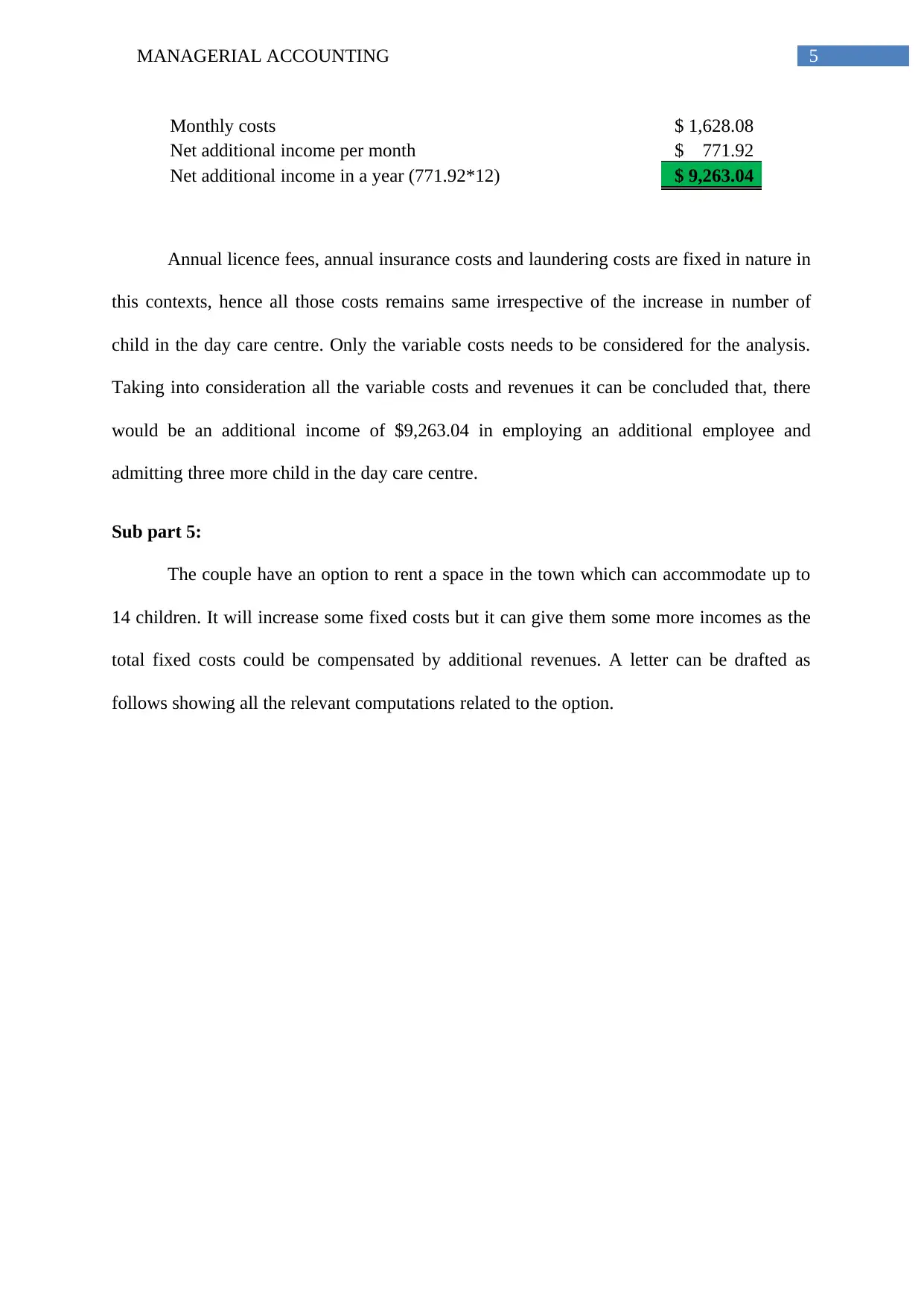
5MANAGERIAL ACCOUNTING
Monthly costs $ 1,628.08
Net additional income per month $ 771.92
Net additional income in a year (771.92*12) $ 9,263.04
Annual licence fees, annual insurance costs and laundering costs are fixed in nature in
this contexts, hence all those costs remains same irrespective of the increase in number of
child in the day care centre. Only the variable costs needs to be considered for the analysis.
Taking into consideration all the variable costs and revenues it can be concluded that, there
would be an additional income of $9,263.04 in employing an additional employee and
admitting three more child in the day care centre.
Sub part 5:
The couple have an option to rent a space in the town which can accommodate up to
14 children. It will increase some fixed costs but it can give them some more incomes as the
total fixed costs could be compensated by additional revenues. A letter can be drafted as
follows showing all the relevant computations related to the option.
Monthly costs $ 1,628.08
Net additional income per month $ 771.92
Net additional income in a year (771.92*12) $ 9,263.04
Annual licence fees, annual insurance costs and laundering costs are fixed in nature in
this contexts, hence all those costs remains same irrespective of the increase in number of
child in the day care centre. Only the variable costs needs to be considered for the analysis.
Taking into consideration all the variable costs and revenues it can be concluded that, there
would be an additional income of $9,263.04 in employing an additional employee and
admitting three more child in the day care centre.
Sub part 5:
The couple have an option to rent a space in the town which can accommodate up to
14 children. It will increase some fixed costs but it can give them some more incomes as the
total fixed costs could be compensated by additional revenues. A letter can be drafted as
follows showing all the relevant computations related to the option.
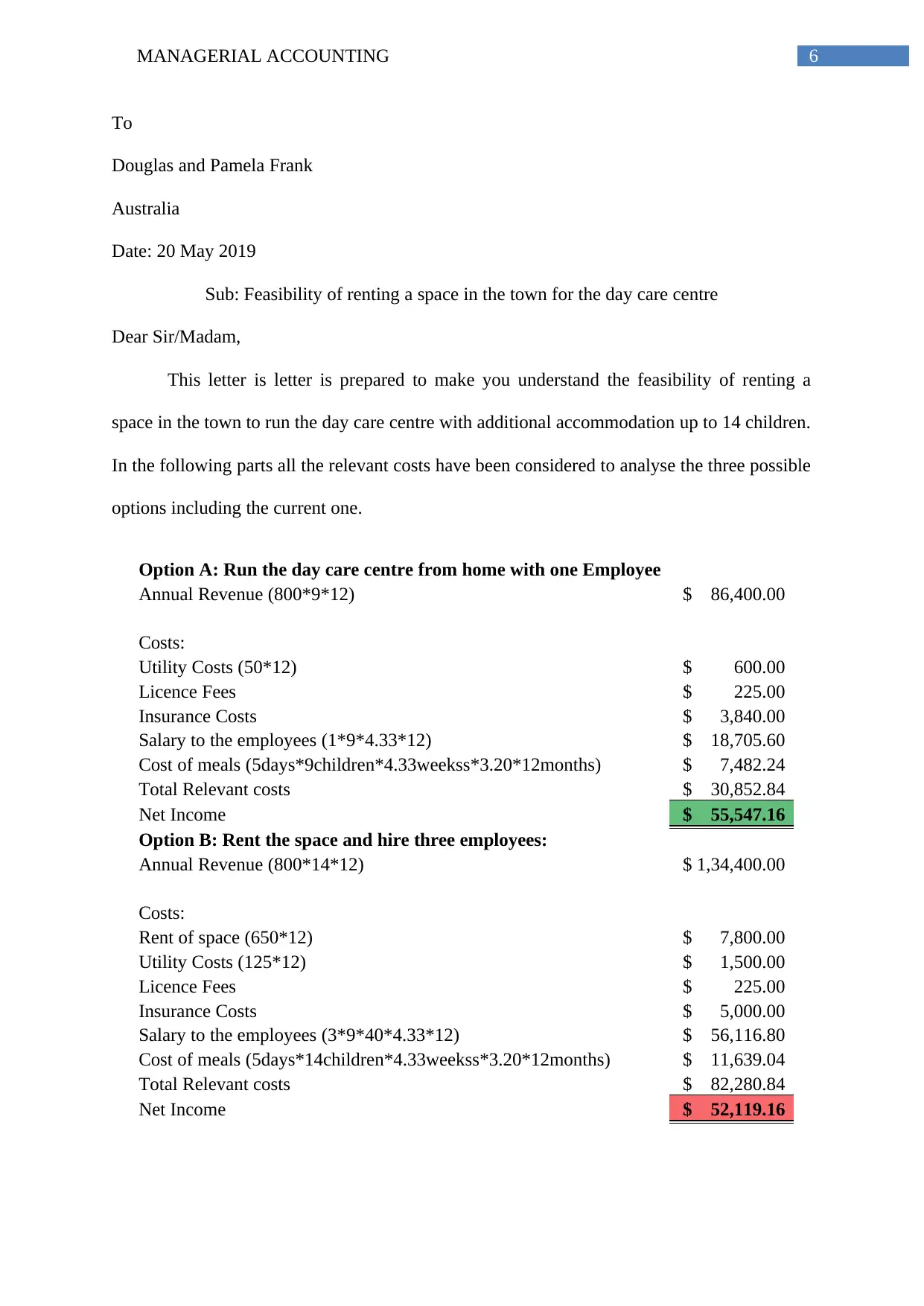
6MANAGERIAL ACCOUNTING
To
Douglas and Pamela Frank
Australia
Date: 20 May 2019
Sub: Feasibility of renting a space in the town for the day care centre
Dear Sir/Madam,
This letter is letter is prepared to make you understand the feasibility of renting a
space in the town to run the day care centre with additional accommodation up to 14 children.
In the following parts all the relevant costs have been considered to analyse the three possible
options including the current one.
Option A: Run the day care centre from home with one Employee
Annual Revenue (800*9*12) $ 86,400.00
Costs:
Utility Costs (50*12) $ 600.00
Licence Fees $ 225.00
Insurance Costs $ 3,840.00
Salary to the employees (1*9*4.33*12) $ 18,705.60
Cost of meals (5days*9children*4.33weekss*3.20*12months) $ 7,482.24
Total Relevant costs $ 30,852.84
Net Income $ 55,547.16
Option B: Rent the space and hire three employees:
Annual Revenue (800*14*12) $ 1,34,400.00
Costs:
Rent of space (650*12) $ 7,800.00
Utility Costs (125*12) $ 1,500.00
Licence Fees $ 225.00
Insurance Costs $ 5,000.00
Salary to the employees (3*9*40*4.33*12) $ 56,116.80
Cost of meals (5days*14children*4.33weekss*3.20*12months) $ 11,639.04
Total Relevant costs $ 82,280.84
Net Income $ 52,119.16
To
Douglas and Pamela Frank
Australia
Date: 20 May 2019
Sub: Feasibility of renting a space in the town for the day care centre
Dear Sir/Madam,
This letter is letter is prepared to make you understand the feasibility of renting a
space in the town to run the day care centre with additional accommodation up to 14 children.
In the following parts all the relevant costs have been considered to analyse the three possible
options including the current one.
Option A: Run the day care centre from home with one Employee
Annual Revenue (800*9*12) $ 86,400.00
Costs:
Utility Costs (50*12) $ 600.00
Licence Fees $ 225.00
Insurance Costs $ 3,840.00
Salary to the employees (1*9*4.33*12) $ 18,705.60
Cost of meals (5days*9children*4.33weekss*3.20*12months) $ 7,482.24
Total Relevant costs $ 30,852.84
Net Income $ 55,547.16
Option B: Rent the space and hire three employees:
Annual Revenue (800*14*12) $ 1,34,400.00
Costs:
Rent of space (650*12) $ 7,800.00
Utility Costs (125*12) $ 1,500.00
Licence Fees $ 225.00
Insurance Costs $ 5,000.00
Salary to the employees (3*9*40*4.33*12) $ 56,116.80
Cost of meals (5days*14children*4.33weekss*3.20*12months) $ 11,639.04
Total Relevant costs $ 82,280.84
Net Income $ 52,119.16
Paraphrase This Document
Need a fresh take? Get an instant paraphrase of this document with our AI Paraphraser
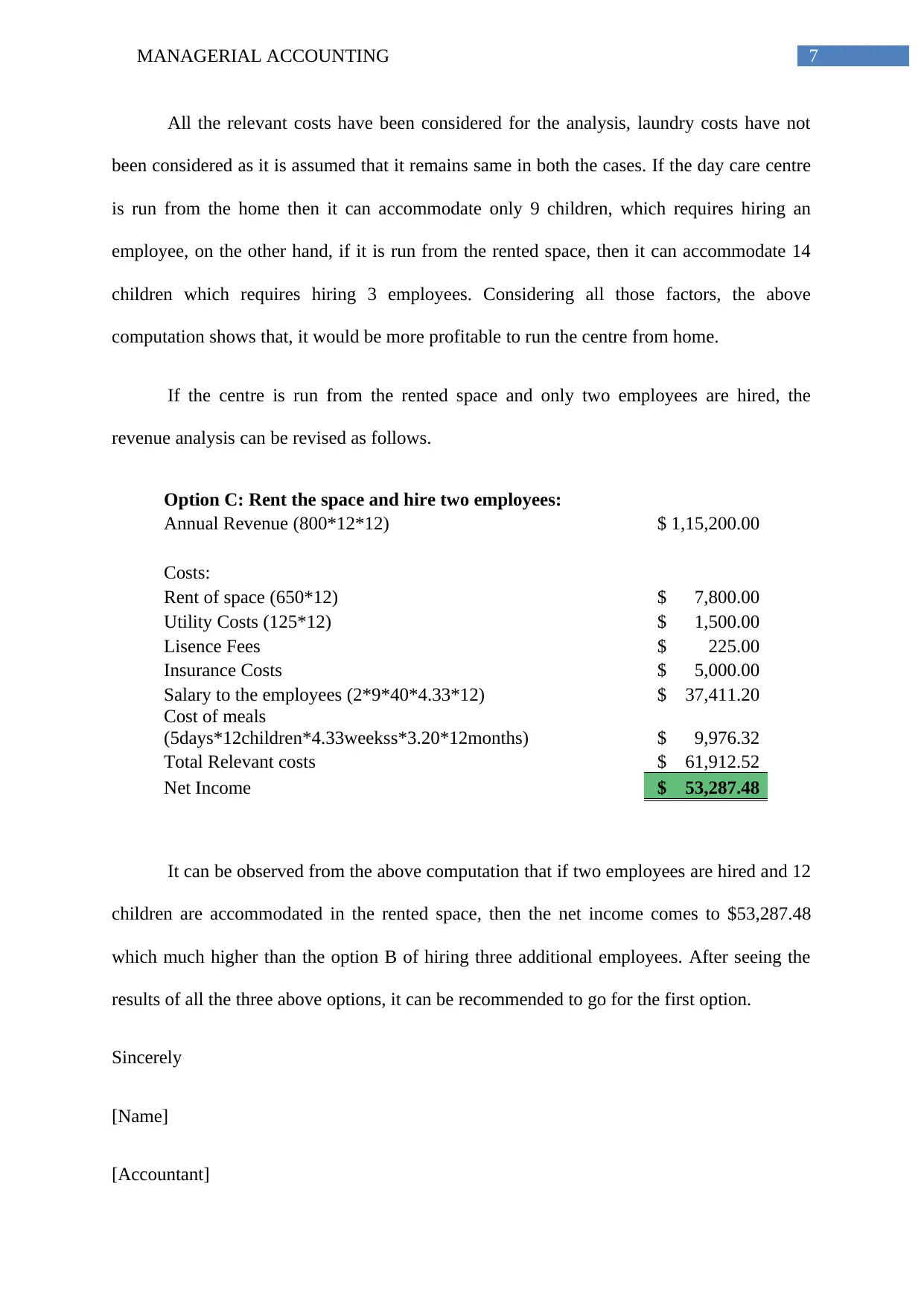
7MANAGERIAL ACCOUNTING
All the relevant costs have been considered for the analysis, laundry costs have not
been considered as it is assumed that it remains same in both the cases. If the day care centre
is run from the home then it can accommodate only 9 children, which requires hiring an
employee, on the other hand, if it is run from the rented space, then it can accommodate 14
children which requires hiring 3 employees. Considering all those factors, the above
computation shows that, it would be more profitable to run the centre from home.
If the centre is run from the rented space and only two employees are hired, the
revenue analysis can be revised as follows.
Option C: Rent the space and hire two employees:
Annual Revenue (800*12*12) $ 1,15,200.00
Costs:
Rent of space (650*12) $ 7,800.00
Utility Costs (125*12) $ 1,500.00
Lisence Fees $ 225.00
Insurance Costs $ 5,000.00
Salary to the employees (2*9*40*4.33*12) $ 37,411.20
Cost of meals
(5days*12children*4.33weekss*3.20*12months) $ 9,976.32
Total Relevant costs $ 61,912.52
Net Income $ 53,287.48
It can be observed from the above computation that if two employees are hired and 12
children are accommodated in the rented space, then the net income comes to $53,287.48
which much higher than the option B of hiring three additional employees. After seeing the
results of all the three above options, it can be recommended to go for the first option.
Sincerely
[Name]
[Accountant]
All the relevant costs have been considered for the analysis, laundry costs have not
been considered as it is assumed that it remains same in both the cases. If the day care centre
is run from the home then it can accommodate only 9 children, which requires hiring an
employee, on the other hand, if it is run from the rented space, then it can accommodate 14
children which requires hiring 3 employees. Considering all those factors, the above
computation shows that, it would be more profitable to run the centre from home.
If the centre is run from the rented space and only two employees are hired, the
revenue analysis can be revised as follows.
Option C: Rent the space and hire two employees:
Annual Revenue (800*12*12) $ 1,15,200.00
Costs:
Rent of space (650*12) $ 7,800.00
Utility Costs (125*12) $ 1,500.00
Lisence Fees $ 225.00
Insurance Costs $ 5,000.00
Salary to the employees (2*9*40*4.33*12) $ 37,411.20
Cost of meals
(5days*12children*4.33weekss*3.20*12months) $ 9,976.32
Total Relevant costs $ 61,912.52
Net Income $ 53,287.48
It can be observed from the above computation that if two employees are hired and 12
children are accommodated in the rented space, then the net income comes to $53,287.48
which much higher than the option B of hiring three additional employees. After seeing the
results of all the three above options, it can be recommended to go for the first option.
Sincerely
[Name]
[Accountant]
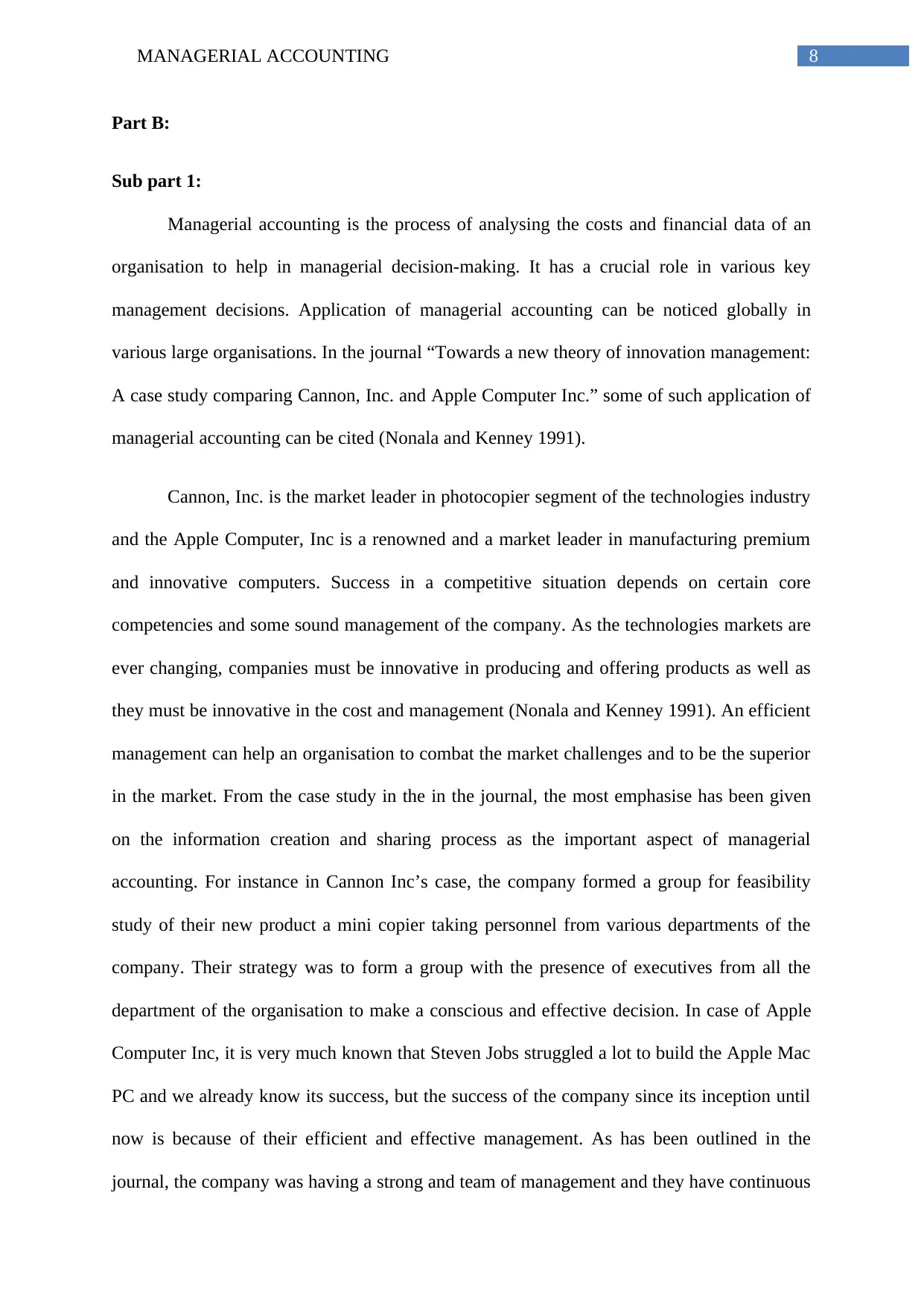
8MANAGERIAL ACCOUNTING
Part B:
Sub part 1:
Managerial accounting is the process of analysing the costs and financial data of an
organisation to help in managerial decision-making. It has a crucial role in various key
management decisions. Application of managerial accounting can be noticed globally in
various large organisations. In the journal “Towards a new theory of innovation management:
A case study comparing Cannon, Inc. and Apple Computer Inc.” some of such application of
managerial accounting can be cited (Nonala and Kenney 1991).
Cannon, Inc. is the market leader in photocopier segment of the technologies industry
and the Apple Computer, Inc is a renowned and a market leader in manufacturing premium
and innovative computers. Success in a competitive situation depends on certain core
competencies and some sound management of the company. As the technologies markets are
ever changing, companies must be innovative in producing and offering products as well as
they must be innovative in the cost and management (Nonala and Kenney 1991). An efficient
management can help an organisation to combat the market challenges and to be the superior
in the market. From the case study in the in the journal, the most emphasise has been given
on the information creation and sharing process as the important aspect of managerial
accounting. For instance in Cannon Inc’s case, the company formed a group for feasibility
study of their new product a mini copier taking personnel from various departments of the
company. Their strategy was to form a group with the presence of executives from all the
department of the organisation to make a conscious and effective decision. In case of Apple
Computer Inc, it is very much known that Steven Jobs struggled a lot to build the Apple Mac
PC and we already know its success, but the success of the company since its inception until
now is because of their efficient and effective management. As has been outlined in the
journal, the company was having a strong and team of management and they have continuous
Part B:
Sub part 1:
Managerial accounting is the process of analysing the costs and financial data of an
organisation to help in managerial decision-making. It has a crucial role in various key
management decisions. Application of managerial accounting can be noticed globally in
various large organisations. In the journal “Towards a new theory of innovation management:
A case study comparing Cannon, Inc. and Apple Computer Inc.” some of such application of
managerial accounting can be cited (Nonala and Kenney 1991).
Cannon, Inc. is the market leader in photocopier segment of the technologies industry
and the Apple Computer, Inc is a renowned and a market leader in manufacturing premium
and innovative computers. Success in a competitive situation depends on certain core
competencies and some sound management of the company. As the technologies markets are
ever changing, companies must be innovative in producing and offering products as well as
they must be innovative in the cost and management (Nonala and Kenney 1991). An efficient
management can help an organisation to combat the market challenges and to be the superior
in the market. From the case study in the in the journal, the most emphasise has been given
on the information creation and sharing process as the important aspect of managerial
accounting. For instance in Cannon Inc’s case, the company formed a group for feasibility
study of their new product a mini copier taking personnel from various departments of the
company. Their strategy was to form a group with the presence of executives from all the
department of the organisation to make a conscious and effective decision. In case of Apple
Computer Inc, it is very much known that Steven Jobs struggled a lot to build the Apple Mac
PC and we already know its success, but the success of the company since its inception until
now is because of their efficient and effective management. As has been outlined in the
journal, the company was having a strong and team of management and they have continuous
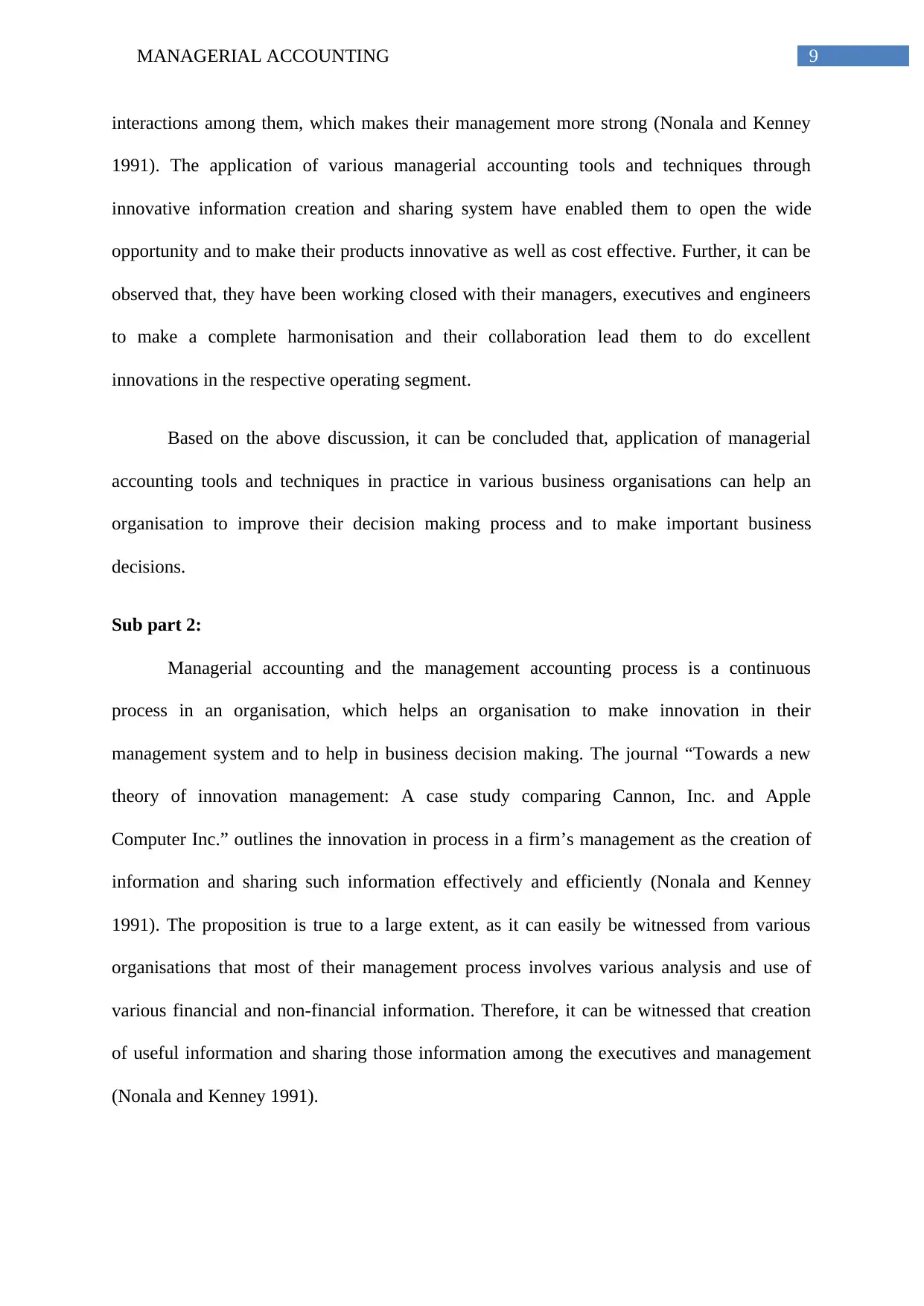
9MANAGERIAL ACCOUNTING
interactions among them, which makes their management more strong (Nonala and Kenney
1991). The application of various managerial accounting tools and techniques through
innovative information creation and sharing system have enabled them to open the wide
opportunity and to make their products innovative as well as cost effective. Further, it can be
observed that, they have been working closed with their managers, executives and engineers
to make a complete harmonisation and their collaboration lead them to do excellent
innovations in the respective operating segment.
Based on the above discussion, it can be concluded that, application of managerial
accounting tools and techniques in practice in various business organisations can help an
organisation to improve their decision making process and to make important business
decisions.
Sub part 2:
Managerial accounting and the management accounting process is a continuous
process in an organisation, which helps an organisation to make innovation in their
management system and to help in business decision making. The journal “Towards a new
theory of innovation management: A case study comparing Cannon, Inc. and Apple
Computer Inc.” outlines the innovation in process in a firm’s management as the creation of
information and sharing such information effectively and efficiently (Nonala and Kenney
1991). The proposition is true to a large extent, as it can easily be witnessed from various
organisations that most of their management process involves various analysis and use of
various financial and non-financial information. Therefore, it can be witnessed that creation
of useful information and sharing those information among the executives and management
(Nonala and Kenney 1991).
interactions among them, which makes their management more strong (Nonala and Kenney
1991). The application of various managerial accounting tools and techniques through
innovative information creation and sharing system have enabled them to open the wide
opportunity and to make their products innovative as well as cost effective. Further, it can be
observed that, they have been working closed with their managers, executives and engineers
to make a complete harmonisation and their collaboration lead them to do excellent
innovations in the respective operating segment.
Based on the above discussion, it can be concluded that, application of managerial
accounting tools and techniques in practice in various business organisations can help an
organisation to improve their decision making process and to make important business
decisions.
Sub part 2:
Managerial accounting and the management accounting process is a continuous
process in an organisation, which helps an organisation to make innovation in their
management system and to help in business decision making. The journal “Towards a new
theory of innovation management: A case study comparing Cannon, Inc. and Apple
Computer Inc.” outlines the innovation in process in a firm’s management as the creation of
information and sharing such information effectively and efficiently (Nonala and Kenney
1991). The proposition is true to a large extent, as it can easily be witnessed from various
organisations that most of their management process involves various analysis and use of
various financial and non-financial information. Therefore, it can be witnessed that creation
of useful information and sharing those information among the executives and management
(Nonala and Kenney 1991).
Secure Best Marks with AI Grader
Need help grading? Try our AI Grader for instant feedback on your assignments.
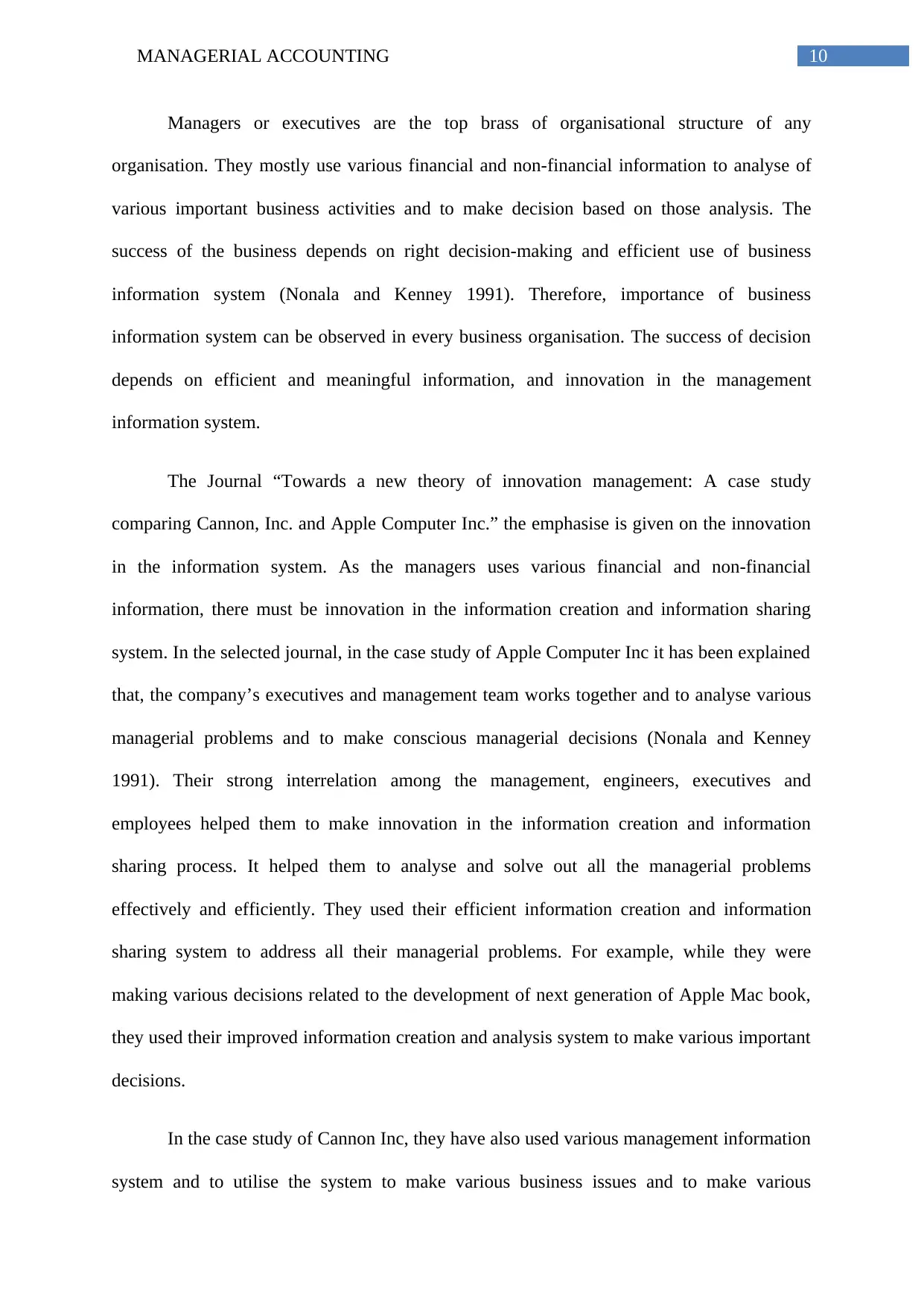
10MANAGERIAL ACCOUNTING
Managers or executives are the top brass of organisational structure of any
organisation. They mostly use various financial and non-financial information to analyse of
various important business activities and to make decision based on those analysis. The
success of the business depends on right decision-making and efficient use of business
information system (Nonala and Kenney 1991). Therefore, importance of business
information system can be observed in every business organisation. The success of decision
depends on efficient and meaningful information, and innovation in the management
information system.
The Journal “Towards a new theory of innovation management: A case study
comparing Cannon, Inc. and Apple Computer Inc.” the emphasise is given on the innovation
in the information system. As the managers uses various financial and non-financial
information, there must be innovation in the information creation and information sharing
system. In the selected journal, in the case study of Apple Computer Inc it has been explained
that, the company’s executives and management team works together and to analyse various
managerial problems and to make conscious managerial decisions (Nonala and Kenney
1991). Their strong interrelation among the management, engineers, executives and
employees helped them to make innovation in the information creation and information
sharing process. It helped them to analyse and solve out all the managerial problems
effectively and efficiently. They used their efficient information creation and information
sharing system to address all their managerial problems. For example, while they were
making various decisions related to the development of next generation of Apple Mac book,
they used their improved information creation and analysis system to make various important
decisions.
In the case study of Cannon Inc, they have also used various management information
system and to utilise the system to make various business issues and to make various
Managers or executives are the top brass of organisational structure of any
organisation. They mostly use various financial and non-financial information to analyse of
various important business activities and to make decision based on those analysis. The
success of the business depends on right decision-making and efficient use of business
information system (Nonala and Kenney 1991). Therefore, importance of business
information system can be observed in every business organisation. The success of decision
depends on efficient and meaningful information, and innovation in the management
information system.
The Journal “Towards a new theory of innovation management: A case study
comparing Cannon, Inc. and Apple Computer Inc.” the emphasise is given on the innovation
in the information system. As the managers uses various financial and non-financial
information, there must be innovation in the information creation and information sharing
system. In the selected journal, in the case study of Apple Computer Inc it has been explained
that, the company’s executives and management team works together and to analyse various
managerial problems and to make conscious managerial decisions (Nonala and Kenney
1991). Their strong interrelation among the management, engineers, executives and
employees helped them to make innovation in the information creation and information
sharing process. It helped them to analyse and solve out all the managerial problems
effectively and efficiently. They used their efficient information creation and information
sharing system to address all their managerial problems. For example, while they were
making various decisions related to the development of next generation of Apple Mac book,
they used their improved information creation and analysis system to make various important
decisions.
In the case study of Cannon Inc, they have also used various management information
system and to utilise the system to make various business issues and to make various
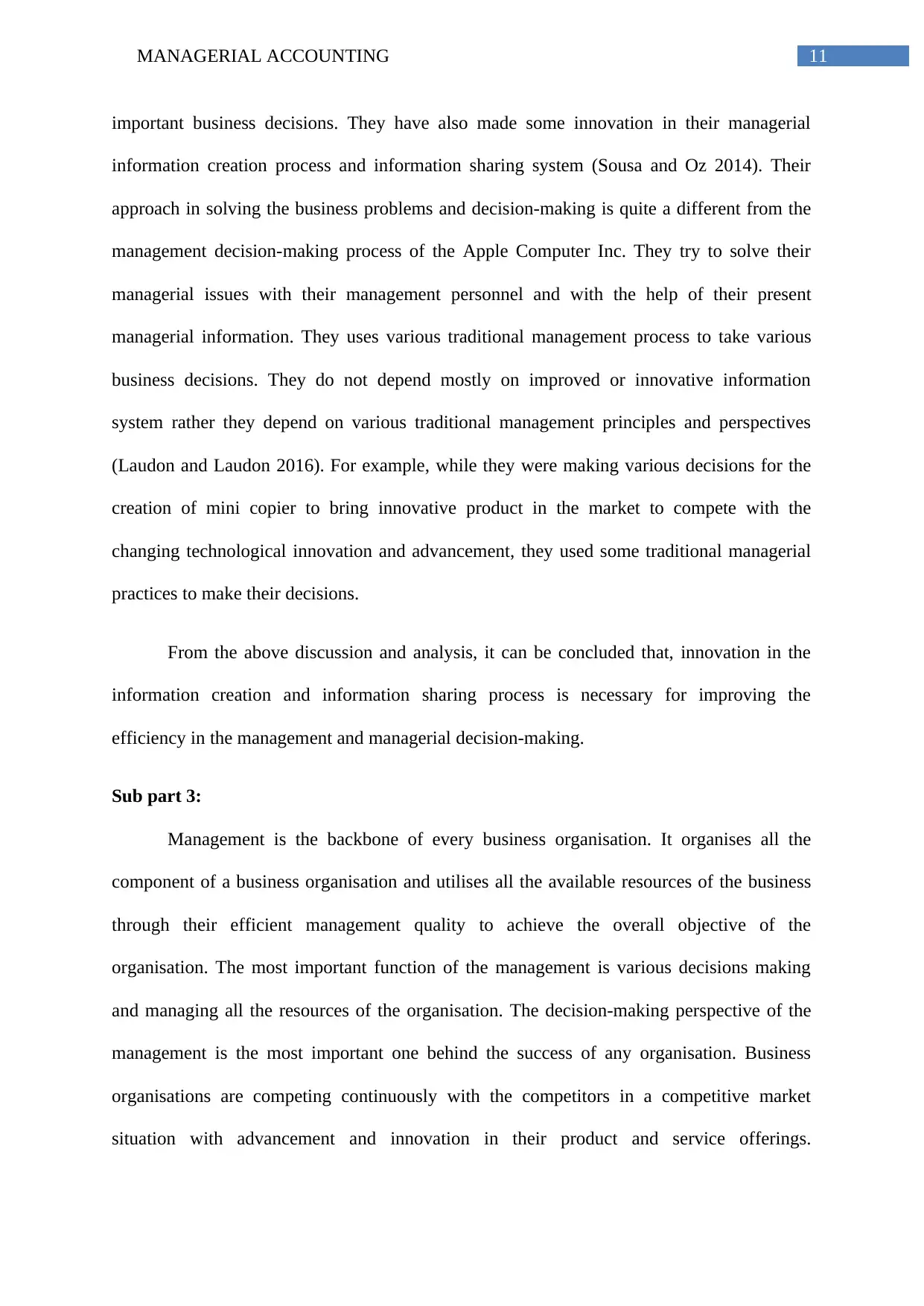
11MANAGERIAL ACCOUNTING
important business decisions. They have also made some innovation in their managerial
information creation process and information sharing system (Sousa and Oz 2014). Their
approach in solving the business problems and decision-making is quite a different from the
management decision-making process of the Apple Computer Inc. They try to solve their
managerial issues with their management personnel and with the help of their present
managerial information. They uses various traditional management process to take various
business decisions. They do not depend mostly on improved or innovative information
system rather they depend on various traditional management principles and perspectives
(Laudon and Laudon 2016). For example, while they were making various decisions for the
creation of mini copier to bring innovative product in the market to compete with the
changing technological innovation and advancement, they used some traditional managerial
practices to make their decisions.
From the above discussion and analysis, it can be concluded that, innovation in the
information creation and information sharing process is necessary for improving the
efficiency in the management and managerial decision-making.
Sub part 3:
Management is the backbone of every business organisation. It organises all the
component of a business organisation and utilises all the available resources of the business
through their efficient management quality to achieve the overall objective of the
organisation. The most important function of the management is various decisions making
and managing all the resources of the organisation. The decision-making perspective of the
management is the most important one behind the success of any organisation. Business
organisations are competing continuously with the competitors in a competitive market
situation with advancement and innovation in their product and service offerings.
important business decisions. They have also made some innovation in their managerial
information creation process and information sharing system (Sousa and Oz 2014). Their
approach in solving the business problems and decision-making is quite a different from the
management decision-making process of the Apple Computer Inc. They try to solve their
managerial issues with their management personnel and with the help of their present
managerial information. They uses various traditional management process to take various
business decisions. They do not depend mostly on improved or innovative information
system rather they depend on various traditional management principles and perspectives
(Laudon and Laudon 2016). For example, while they were making various decisions for the
creation of mini copier to bring innovative product in the market to compete with the
changing technological innovation and advancement, they used some traditional managerial
practices to make their decisions.
From the above discussion and analysis, it can be concluded that, innovation in the
information creation and information sharing process is necessary for improving the
efficiency in the management and managerial decision-making.
Sub part 3:
Management is the backbone of every business organisation. It organises all the
component of a business organisation and utilises all the available resources of the business
through their efficient management quality to achieve the overall objective of the
organisation. The most important function of the management is various decisions making
and managing all the resources of the organisation. The decision-making perspective of the
management is the most important one behind the success of any organisation. Business
organisations are competing continuously with the competitors in a competitive market
situation with advancement and innovation in their product and service offerings.
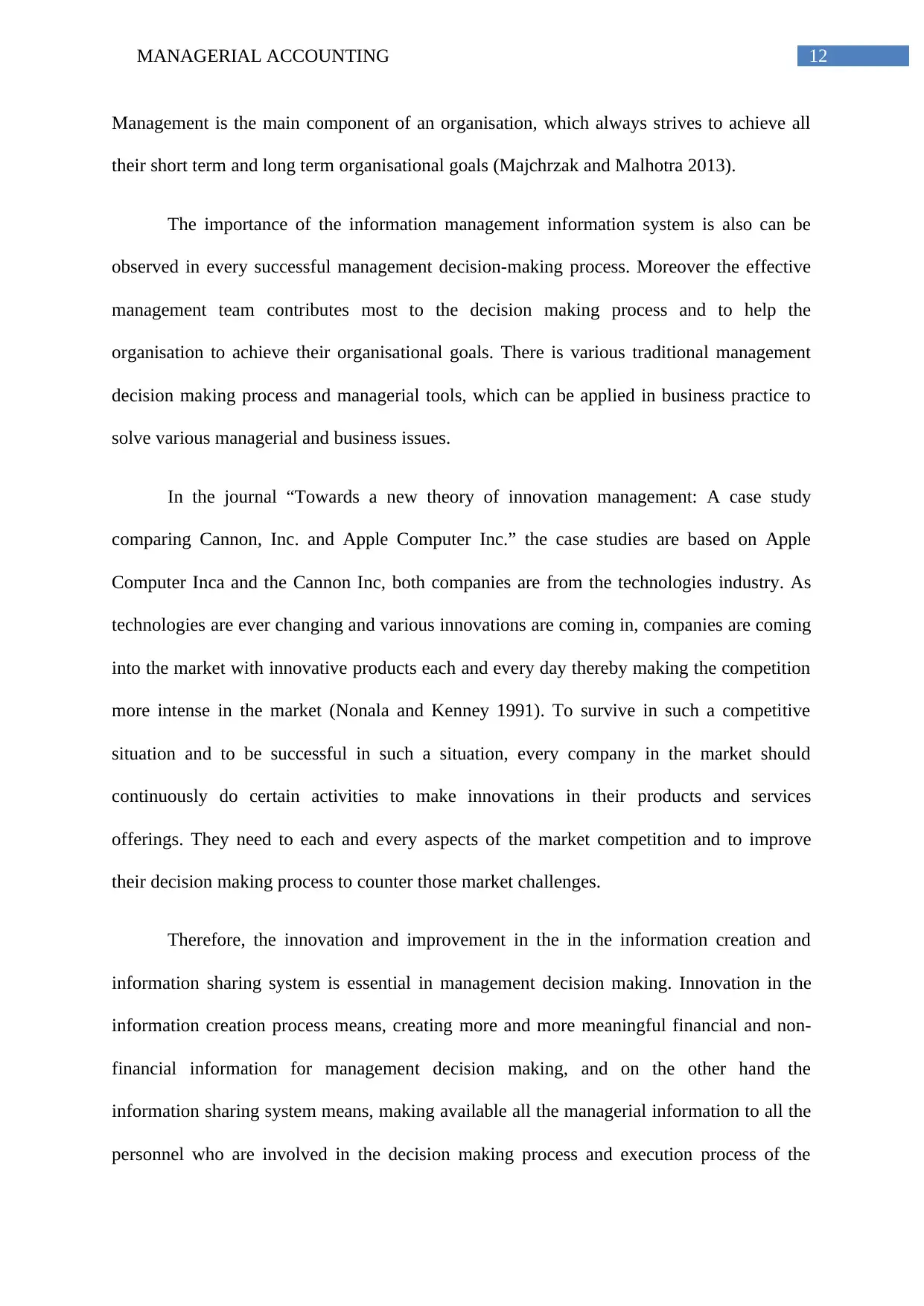
12MANAGERIAL ACCOUNTING
Management is the main component of an organisation, which always strives to achieve all
their short term and long term organisational goals (Majchrzak and Malhotra 2013).
The importance of the information management information system is also can be
observed in every successful management decision-making process. Moreover the effective
management team contributes most to the decision making process and to help the
organisation to achieve their organisational goals. There is various traditional management
decision making process and managerial tools, which can be applied in business practice to
solve various managerial and business issues.
In the journal “Towards a new theory of innovation management: A case study
comparing Cannon, Inc. and Apple Computer Inc.” the case studies are based on Apple
Computer Inca and the Cannon Inc, both companies are from the technologies industry. As
technologies are ever changing and various innovations are coming in, companies are coming
into the market with innovative products each and every day thereby making the competition
more intense in the market (Nonala and Kenney 1991). To survive in such a competitive
situation and to be successful in such a situation, every company in the market should
continuously do certain activities to make innovations in their products and services
offerings. They need to each and every aspects of the market competition and to improve
their decision making process to counter those market challenges.
Therefore, the innovation and improvement in the in the information creation and
information sharing system is essential in management decision making. Innovation in the
information creation process means, creating more and more meaningful financial and non-
financial information for management decision making, and on the other hand the
information sharing system means, making available all the managerial information to all the
personnel who are involved in the decision making process and execution process of the
Management is the main component of an organisation, which always strives to achieve all
their short term and long term organisational goals (Majchrzak and Malhotra 2013).
The importance of the information management information system is also can be
observed in every successful management decision-making process. Moreover the effective
management team contributes most to the decision making process and to help the
organisation to achieve their organisational goals. There is various traditional management
decision making process and managerial tools, which can be applied in business practice to
solve various managerial and business issues.
In the journal “Towards a new theory of innovation management: A case study
comparing Cannon, Inc. and Apple Computer Inc.” the case studies are based on Apple
Computer Inca and the Cannon Inc, both companies are from the technologies industry. As
technologies are ever changing and various innovations are coming in, companies are coming
into the market with innovative products each and every day thereby making the competition
more intense in the market (Nonala and Kenney 1991). To survive in such a competitive
situation and to be successful in such a situation, every company in the market should
continuously do certain activities to make innovations in their products and services
offerings. They need to each and every aspects of the market competition and to improve
their decision making process to counter those market challenges.
Therefore, the innovation and improvement in the in the information creation and
information sharing system is essential in management decision making. Innovation in the
information creation process means, creating more and more meaningful financial and non-
financial information for management decision making, and on the other hand the
information sharing system means, making available all the managerial information to all the
personnel who are involved in the decision making process and execution process of the
Paraphrase This Document
Need a fresh take? Get an instant paraphrase of this document with our AI Paraphraser
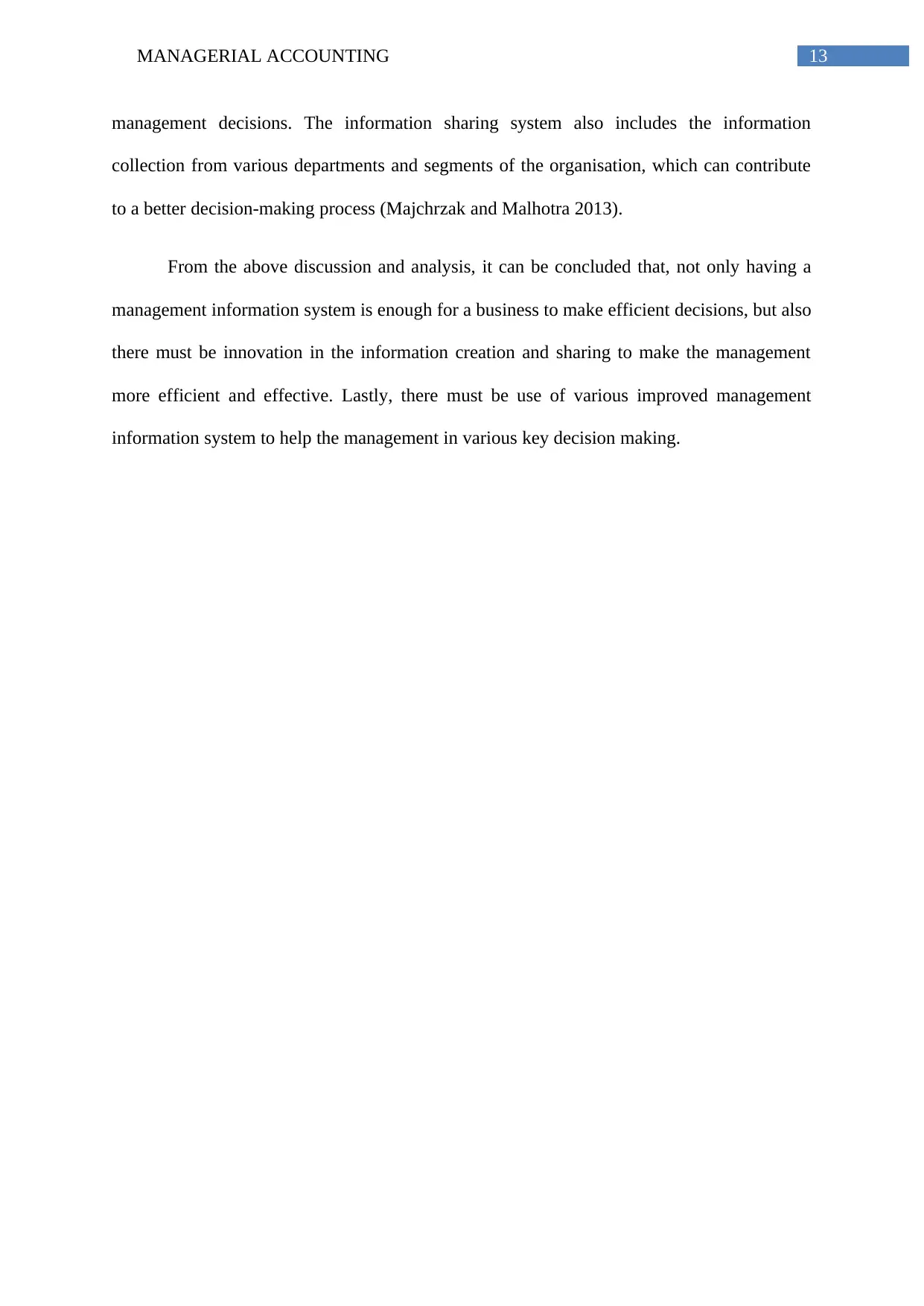
13MANAGERIAL ACCOUNTING
management decisions. The information sharing system also includes the information
collection from various departments and segments of the organisation, which can contribute
to a better decision-making process (Majchrzak and Malhotra 2013).
From the above discussion and analysis, it can be concluded that, not only having a
management information system is enough for a business to make efficient decisions, but also
there must be innovation in the information creation and sharing to make the management
more efficient and effective. Lastly, there must be use of various improved management
information system to help the management in various key decision making.
management decisions. The information sharing system also includes the information
collection from various departments and segments of the organisation, which can contribute
to a better decision-making process (Majchrzak and Malhotra 2013).
From the above discussion and analysis, it can be concluded that, not only having a
management information system is enough for a business to make efficient decisions, but also
there must be innovation in the information creation and sharing to make the management
more efficient and effective. Lastly, there must be use of various improved management
information system to help the management in various key decision making.
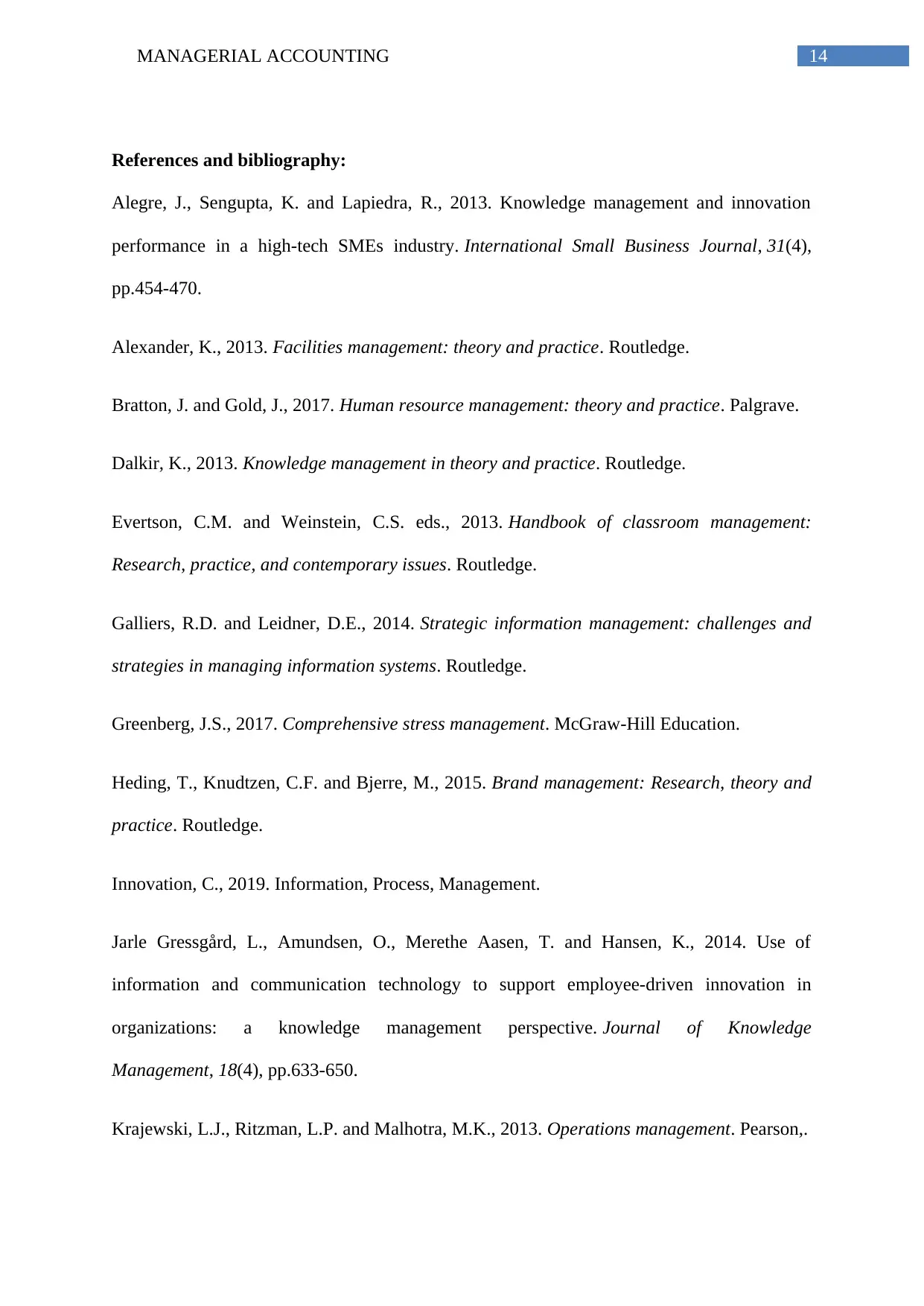
14MANAGERIAL ACCOUNTING
References and bibliography:
Alegre, J., Sengupta, K. and Lapiedra, R., 2013. Knowledge management and innovation
performance in a high-tech SMEs industry. International Small Business Journal, 31(4),
pp.454-470.
Alexander, K., 2013. Facilities management: theory and practice. Routledge.
Bratton, J. and Gold, J., 2017. Human resource management: theory and practice. Palgrave.
Dalkir, K., 2013. Knowledge management in theory and practice. Routledge.
Evertson, C.M. and Weinstein, C.S. eds., 2013. Handbook of classroom management:
Research, practice, and contemporary issues. Routledge.
Galliers, R.D. and Leidner, D.E., 2014. Strategic information management: challenges and
strategies in managing information systems. Routledge.
Greenberg, J.S., 2017. Comprehensive stress management. McGraw-Hill Education.
Heding, T., Knudtzen, C.F. and Bjerre, M., 2015. Brand management: Research, theory and
practice. Routledge.
Innovation, C., 2019. Information, Process, Management.
Jarle Gressgård, L., Amundsen, O., Merethe Aasen, T. and Hansen, K., 2014. Use of
information and communication technology to support employee-driven innovation in
organizations: a knowledge management perspective. Journal of Knowledge
Management, 18(4), pp.633-650.
Krajewski, L.J., Ritzman, L.P. and Malhotra, M.K., 2013. Operations management. Pearson,.
References and bibliography:
Alegre, J., Sengupta, K. and Lapiedra, R., 2013. Knowledge management and innovation
performance in a high-tech SMEs industry. International Small Business Journal, 31(4),
pp.454-470.
Alexander, K., 2013. Facilities management: theory and practice. Routledge.
Bratton, J. and Gold, J., 2017. Human resource management: theory and practice. Palgrave.
Dalkir, K., 2013. Knowledge management in theory and practice. Routledge.
Evertson, C.M. and Weinstein, C.S. eds., 2013. Handbook of classroom management:
Research, practice, and contemporary issues. Routledge.
Galliers, R.D. and Leidner, D.E., 2014. Strategic information management: challenges and
strategies in managing information systems. Routledge.
Greenberg, J.S., 2017. Comprehensive stress management. McGraw-Hill Education.
Heding, T., Knudtzen, C.F. and Bjerre, M., 2015. Brand management: Research, theory and
practice. Routledge.
Innovation, C., 2019. Information, Process, Management.
Jarle Gressgård, L., Amundsen, O., Merethe Aasen, T. and Hansen, K., 2014. Use of
information and communication technology to support employee-driven innovation in
organizations: a knowledge management perspective. Journal of Knowledge
Management, 18(4), pp.633-650.
Krajewski, L.J., Ritzman, L.P. and Malhotra, M.K., 2013. Operations management. Pearson,.
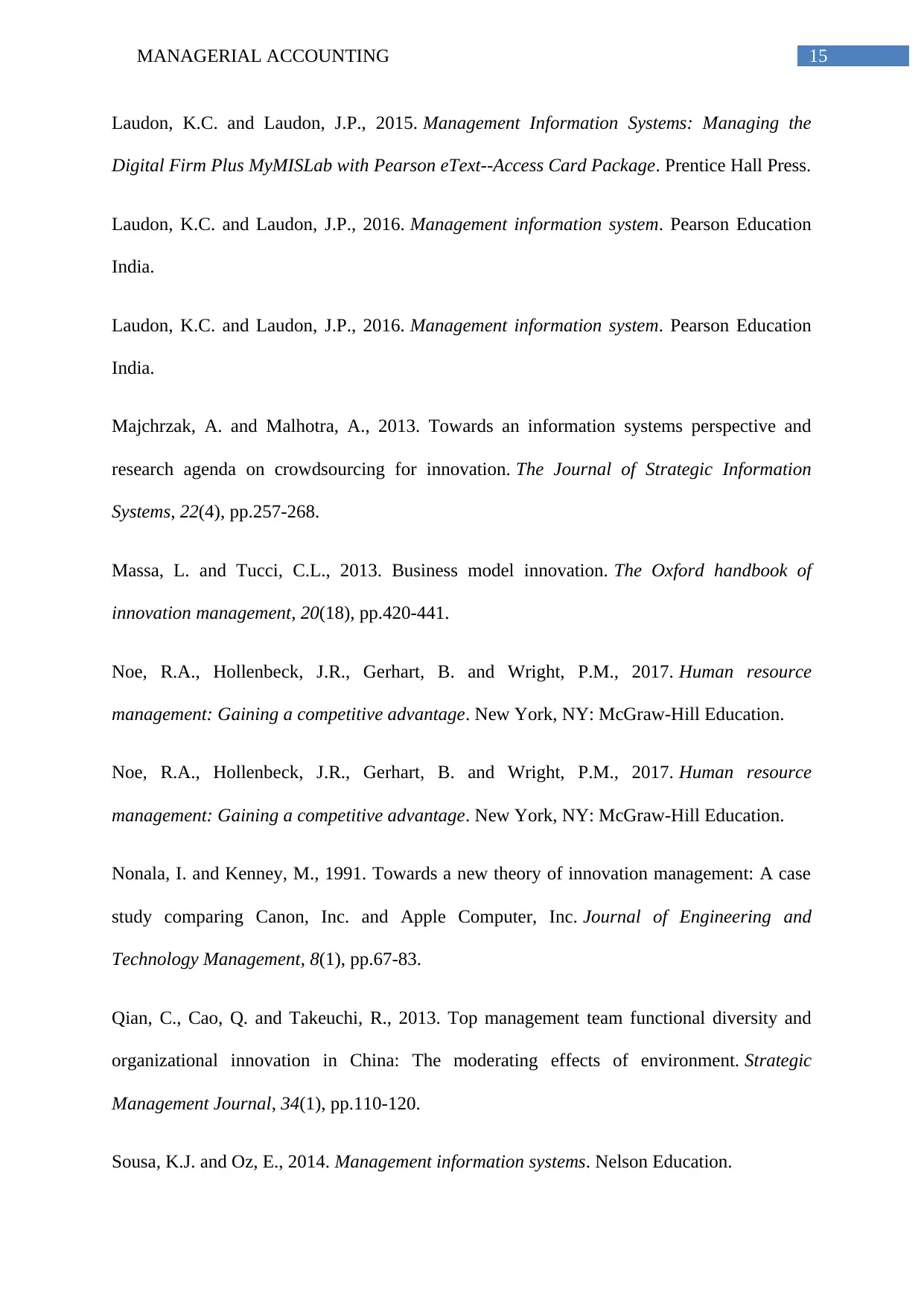
15MANAGERIAL ACCOUNTING
Laudon, K.C. and Laudon, J.P., 2015. Management Information Systems: Managing the
Digital Firm Plus MyMISLab with Pearson eText--Access Card Package. Prentice Hall Press.
Laudon, K.C. and Laudon, J.P., 2016. Management information system. Pearson Education
India.
Laudon, K.C. and Laudon, J.P., 2016. Management information system. Pearson Education
India.
Majchrzak, A. and Malhotra, A., 2013. Towards an information systems perspective and
research agenda on crowdsourcing for innovation. The Journal of Strategic Information
Systems, 22(4), pp.257-268.
Massa, L. and Tucci, C.L., 2013. Business model innovation. The Oxford handbook of
innovation management, 20(18), pp.420-441.
Noe, R.A., Hollenbeck, J.R., Gerhart, B. and Wright, P.M., 2017. Human resource
management: Gaining a competitive advantage. New York, NY: McGraw-Hill Education.
Noe, R.A., Hollenbeck, J.R., Gerhart, B. and Wright, P.M., 2017. Human resource
management: Gaining a competitive advantage. New York, NY: McGraw-Hill Education.
Nonala, I. and Kenney, M., 1991. Towards a new theory of innovation management: A case
study comparing Canon, Inc. and Apple Computer, Inc. Journal of Engineering and
Technology Management, 8(1), pp.67-83.
Qian, C., Cao, Q. and Takeuchi, R., 2013. Top management team functional diversity and
organizational innovation in China: The moderating effects of environment. Strategic
Management Journal, 34(1), pp.110-120.
Sousa, K.J. and Oz, E., 2014. Management information systems. Nelson Education.
Laudon, K.C. and Laudon, J.P., 2015. Management Information Systems: Managing the
Digital Firm Plus MyMISLab with Pearson eText--Access Card Package. Prentice Hall Press.
Laudon, K.C. and Laudon, J.P., 2016. Management information system. Pearson Education
India.
Laudon, K.C. and Laudon, J.P., 2016. Management information system. Pearson Education
India.
Majchrzak, A. and Malhotra, A., 2013. Towards an information systems perspective and
research agenda on crowdsourcing for innovation. The Journal of Strategic Information
Systems, 22(4), pp.257-268.
Massa, L. and Tucci, C.L., 2013. Business model innovation. The Oxford handbook of
innovation management, 20(18), pp.420-441.
Noe, R.A., Hollenbeck, J.R., Gerhart, B. and Wright, P.M., 2017. Human resource
management: Gaining a competitive advantage. New York, NY: McGraw-Hill Education.
Noe, R.A., Hollenbeck, J.R., Gerhart, B. and Wright, P.M., 2017. Human resource
management: Gaining a competitive advantage. New York, NY: McGraw-Hill Education.
Nonala, I. and Kenney, M., 1991. Towards a new theory of innovation management: A case
study comparing Canon, Inc. and Apple Computer, Inc. Journal of Engineering and
Technology Management, 8(1), pp.67-83.
Qian, C., Cao, Q. and Takeuchi, R., 2013. Top management team functional diversity and
organizational innovation in China: The moderating effects of environment. Strategic
Management Journal, 34(1), pp.110-120.
Sousa, K.J. and Oz, E., 2014. Management information systems. Nelson Education.
Secure Best Marks with AI Grader
Need help grading? Try our AI Grader for instant feedback on your assignments.
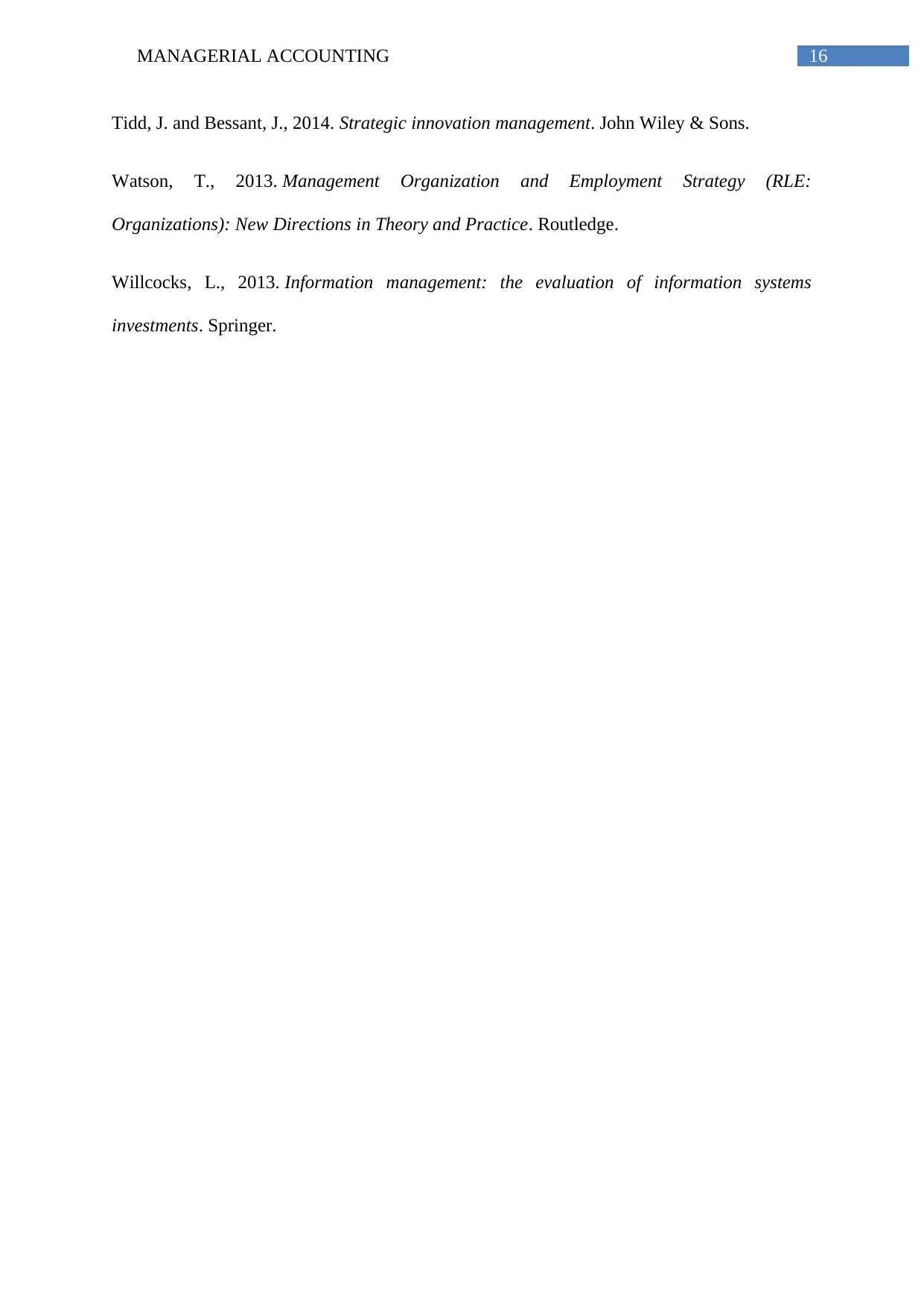
16MANAGERIAL ACCOUNTING
Tidd, J. and Bessant, J., 2014. Strategic innovation management. John Wiley & Sons.
Watson, T., 2013. Management Organization and Employment Strategy (RLE:
Organizations): New Directions in Theory and Practice. Routledge.
Willcocks, L., 2013. Information management: the evaluation of information systems
investments. Springer.
Tidd, J. and Bessant, J., 2014. Strategic innovation management. John Wiley & Sons.
Watson, T., 2013. Management Organization and Employment Strategy (RLE:
Organizations): New Directions in Theory and Practice. Routledge.
Willcocks, L., 2013. Information management: the evaluation of information systems
investments. Springer.
1 out of 17
Related Documents
Your All-in-One AI-Powered Toolkit for Academic Success.
+13062052269
info@desklib.com
Available 24*7 on WhatsApp / Email
![[object Object]](/_next/static/media/star-bottom.7253800d.svg)
Unlock your academic potential
© 2024 | Zucol Services PVT LTD | All rights reserved.




